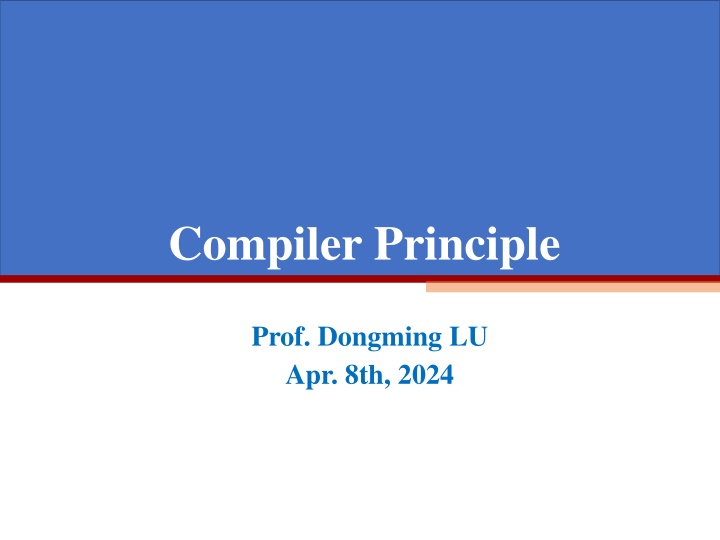
Compiler Principles and Intermediate Code
"Explore the fundamental concepts of compiler principles, including lexical analysis, parsing, and semantic analysis. Learn about the importance of translation to intermediate code and its role in optimizing machine language generation."
Download Presentation

Please find below an Image/Link to download the presentation.
The content on the website is provided AS IS for your information and personal use only. It may not be sold, licensed, or shared on other websites without obtaining consent from the author. If you encounter any issues during the download, it is possible that the publisher has removed the file from their server.
You are allowed to download the files provided on this website for personal or commercial use, subject to the condition that they are used lawfully. All files are the property of their respective owners.
The content on the website is provided AS IS for your information and personal use only. It may not be sold, licensed, or shared on other websites without obtaining consent from the author.
E N D
Presentation Transcript
Compiler Principle Prof. Dongming LU Apr. 8th, 2024
Content 1. INTRODUCTION 2. 3. 4. 5. LEXICAL ANALYSIS PARSING ABSTRACT SYNTAX SEMANTIC ANALYSIS 6. 7. ACTIVATION RECORD TRANSLATING INTO INTERMEDIATE CODE 8. OTHERS
Where we are Lexical Analysis Source Code Parsing Code Generation Semantic Analysis Optimization IR Generation http://tse1.mm.bing.net/th?id=OIP.Meddfd08a07eb6695485d3bd8dde49eceo0w=299h=205c=0pid=1.9rs=0p=0 IR Optimization Machine Code
Motivation Translating directly to real machine code hinders portability and modularity.
Motivation The front end lexical analysis Parsing Semantic analysis Translation to intermediate representation. The back end IR optimization Translation into machine language.
What is Intermediate Code An intermediate representation (IR) is a kind of abstract machine language Express the target-machine operations without committing to too much machine-specific detail. Be independent of the details of the source language.
What is Intermediate Code IR: Three-Address Code Basic instruction: x = y op z Given expression: 2*a+(b-3) the corresponding three-address instructions are as follows: T1 = 2 * a T2 = b 3 T3 = T1 + T2
What is Intermediate Code IR: Three-Address Code Four fields are necessary (a quadruple) One for the operation Three for the addresses One or more of the address fields is given a null or empty value The instructions is implemented as An array Linked list. entire sequence of three-address
Example Three-address code High-level language read x ; { input an integer } if 0 < x then { don t compute if x <= 0 } fact:=1; repeat fact:=fact*x; x:=x-1 until x=0; write fact { output factorial of x } end read x t1=x>0 if_false t1 goto L1 fact=1 label L2 t2 = fact * x fact = t2 t3 = x - 1 x = t3 t4= x= =0 if_false t4 goto L2 write fact label L1 halt
The requirements for IR A good intermediate representation has several qualities Convenient for the semantic analysis phase to produce. Convenient to translate into all real machine language. Each construct must have a clear and simple meaning, IR optimizing transformations can easily be specified and implemented.
/*tree.h*/ Typedef struct T_exp_ *T_exp; Struct T_exp_ {enum {T_BINOP, T_MEM, T_TEMP, , T_CALL} kind; union {struct {T_binop op; T_exp left, right;} BINOP; } u; }; T_exp T_Binop(T_binOp, T_exp, T_exp); T_exp T_Mem(T_exp); T_exp T_Temp(Temp_temp); T_exp T_Eseq(T_stm, T_exp); T_exp T_Name(Temp_label); T_exp T_const(int); T_exp T_call(T_exp, T_expList); Figure 7.2 The intermediate representation tree
The expressions (T_exp) CONST(i) The integer constant i NAME(n) The symbolic constant n (e.g. label) TEMP(t) Temporary t. BINOP(o, e1, e2) The application of binary operator o to operands e1, e2. The integer arithmetic operators are PLUS, MINUS, MUL, DIV; the integer bitwise logical operators are AND, OR, XOR; the integer logical shift operators are LSHIFT, RSHIFT; the integer arithmetic right-shift is ARSHIFT. MEM(e) The contents of wordSize bytes of memory starting at address e. When MEM is used as the left child of a MOVE, it means "store", but anywhere else it means "fetch . CALL(f, l) A procedure call: the application of function f to argument list l. ESEQ(s, e) The statement s is evaluated for side effects, then e is evaluated for a result.
/*tree.h*/ Typedef struct T_stm_ *T_stm; Struct T_stm_ {enum {T_SEQ, T_LABEL, T_JUMP, , T_EXP} kind; union {struct {T_stm left, right;} SEQ; } u; }; T_stm T_seq(T_stm left, T_stm right); T_stm T_Label(Temp_label); T_stm T_Jump(T_exp exp, Temp_labelList labels); T_stm T_Cjump(T_relOp op, T_exp left, T_exp rght, Temp_label true, Temp_label false); T_stm T_move(T_exp, T_exp); T_stm T_exp(T_exp); Figure 7.2 The intermediate representation tree
The statements (T_stm) MOVE(TEMP t, e) Evaluate e and move it into temporary t. MOVE(MEM(e1) e2) Evaluate e1, yielding address a. Then evaluate e2, and store the result into wordSize bytes of memory starting at a. Evaluate e and discard the result. EXP(e) JUMP(e, labs) Transfer control (jump) to address e. The destination e may be a literal label, as in NAME(lab), or it may be an address calculated by any other kind of expression. CJUMP(o, e1, e2, t, f) Evaluate e1, e2in that order, yielding values a, b. Then compare a, b using the relational operator o. If the result is true, jump to t; otherwise jump to f. SEQ(s1, s2) The statement s1followed by s2. LABEL(n) Define the constant value of name n to be the current machine code address.
/*tree.h*/ Typedef struct T_expList_ *T_expList; Struct T_expList_ {T_exp head; T_expList tail;}; T_expList T_ExpList(T_exp head, T_expList tail); Typedef struct T_stmList_ *T_stmList; Struct T_stmList_ {T_stm head; T_stmList tail;}; T_stmList T_StmList(T_stm head, T_stmList tail); Typedef enum {T_plus, T_minus, T_mul, T_div, T_and, T_or, T_lshift, T_rshift, T_arshift, T_xor} T_binOp; Typedef enum {T_eq, T_ne, T_lt, T_gt, T_le, T_ge, T_ult, T_ule, T_ugt, T_uge} T_relOp; Figure 7.2 The intermediate representation tree






















